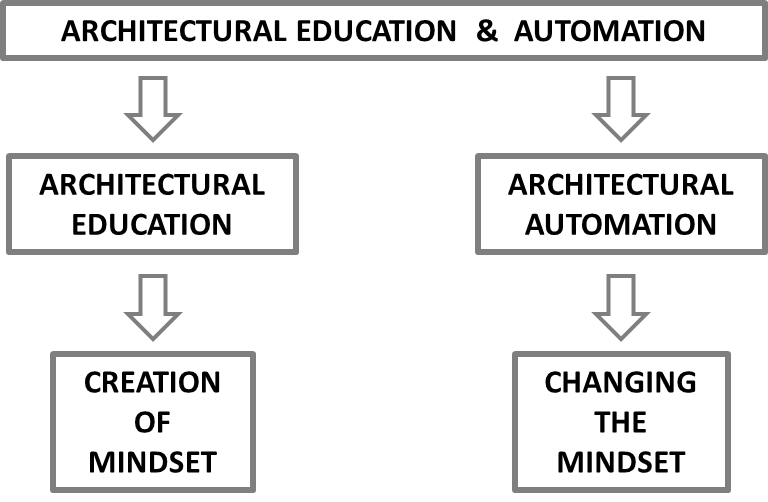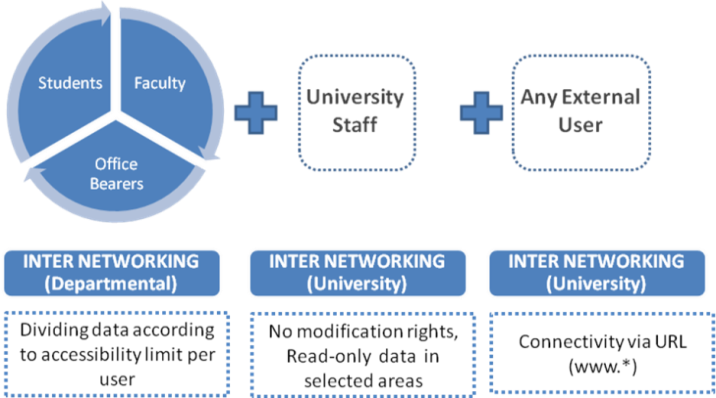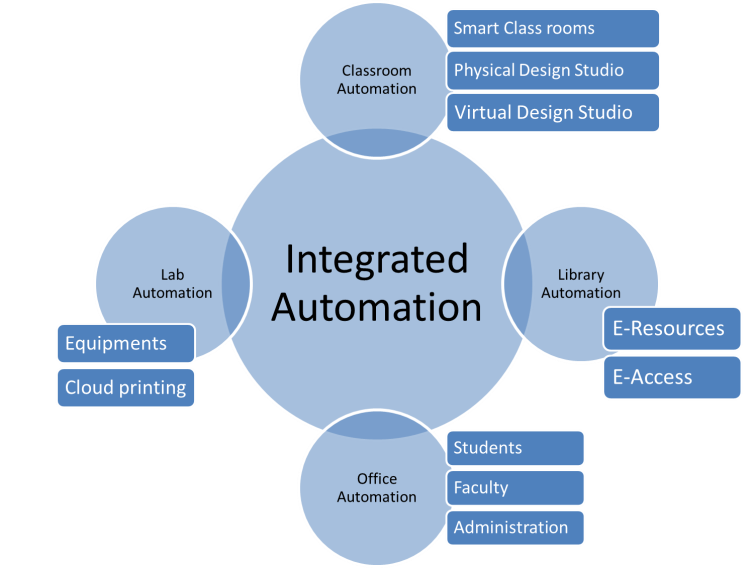-
Paper Information
- Paper Submission
-
Journal Information
- About This Journal
- Editorial Board
- Current Issue
- Archive
- Author Guidelines
- Contact Us
Architecture Research
p-ISSN: 2168-507X e-ISSN: 2168-5088
2015; 5(4): 121-124
doi:10.5923/j.arch.20150504.03

Effective Learning through Integrated Automation in Architectural Education: A Model Framework
Mohammad Saquib1, M. Arif Kamal2
1Faculty of Architecture and Ekistics, Jamia Millia Islamia, New Delhi, India
2Department. of Architecture, ZHCET, Aligarh Muslim University, Aligarh, India
Correspondence to: M. Arif Kamal, Department. of Architecture, ZHCET, Aligarh Muslim University, Aligarh, India.
| Email: |  |
Copyright © 2015 Scientific & Academic Publishing. All Rights Reserved.
This work is licensed under the Creative Commons Attribution International License (CC BY).
http://creativecommons.org/licenses/by/4.0/

Automation has been a widely used term in the manufacturing field since decades but lately it has been used in every other discipline including education. Higher education today is one of the major research areas under ‘Automation’ and learning today is more technology oriented than ever encompassing a number of automated equipment. Though automated equipment exists today, but they work in isolation creating hindrance in cross platform interaction. The effectiveness of learning in Architectural Education is a major concern with rapid developments in technology and their adaptation in teaching and learning techniques and processes including the design studio. This paper is an attempt to create a model frame work for establishing integrated automation for an effective and connected learning and administrative environment in Architectural Education.
Keywords: Integrated Automation, Architectural Education, Classroom Automation, Design Studio
Cite this paper: Mohammad Saquib, M. Arif Kamal, Effective Learning through Integrated Automation in Architectural Education: A Model Framework, Architecture Research, Vol. 5 No. 4, 2015, pp. 121-124. doi: 10.5923/j.arch.20150504.03.
Article Outline
1. Introduction
- The intensive application of computers and information & communication technology (ICT) in Architecture has challenged us to re-think common practices in architectural education. The term ‘Automation’ means to make an object work automatically. It is the use of control systems such as computers to control industrial machinery systems and processes, reducing the need for human intervention. Automation plays an increasingly important role in the global economy and in daily experience. Engineers strive to combine automated devices with mathematical and organizational tools to create complex systems for a rapidly expanding range of applications and human activities. Integrated automation stands for collective automation of a group of things such that they can be synchronized, used and managed more effectively. Integrated automation is not a ready-made package that can be installed right away; instead it requires a logical thinking of the ways in which automation can be done to achieve the maximum potential gains. Integrated technologies make life simpler by linking all the things together and placing its controls at a single point from where they can be used and managed easily. Even the field of academics is not left untouched from these contemporary technologies and software giants have poured in huge sums to come up with ideas such as “Intelligent Campus” and “Intelligent Classroom” where technology is integrated with the campus life and teaching techniques to obtain the maximum benefit [1]. Automation is not a technology being used in isolation; in fact it is integration of technologies to enhance cross platform interaction. Examples of such integration are Workplace automation and educational automation technologies such as Networking, Campus Wi-fi, Blended learning Classroom, Virtual Design Studio etc [2].
2. Research Methodology
- In this paper, qualitative research methodology is used. This paper analyses the effectiveness of adaptation of technology in teaching and learning techniques and processes in Architectural Education, including the design studio. This paper bring forth a model frame work for establishing integrated automation for an effective and connected learning and administrative environment in Architectural Education.
3. The Scope of Integrated Automation in Architectural Education
- Many studies and researches have been done on the use and integration of digital technology in design and architectural education which are majorly concerned with enhancing communication amongst designers or to would-be Architects. Integrated Automation is now very much a reality and is in use in present day work environment. Integrated automation will change the way, we perceive Architecture Education from start to end; i.e. it’s imparting, it’s assessment, it’s management and its reach, without compromising with the teaching standards. In other words, if Architectural Education is about creation of the right mindset so that student can find the right a solution, Integrated Automation Technology is about changing the mindset, such that the things work more effectively. Further, with the increasing number of seats in Architectural schools and growing complexity in effective handling of teaching and administration it becomes important to increase productivity and standardize teaching system to its maximum potential for a minimum acceptable quality standard. Figure 1 illustrates the scope of Integrated Automation in Architectural Education.
 | Figure 1. Scope of Integrated Automation in Architectural Education (Source: Authors) |
4. Components for Integrated Automation in Architectural Education
- Why we need automation at all is as simple as why we need a mobile, a laptop or a tablet these days. What is today perceived as an upcoming technology will definitely be a necessity in the coming days. Further, with the advancement of technology, it becomes important to integrate education system with automation technology so that the best methods in teaching can be worked out [3]. Despite undergoing complete automation, space for manual work approach should always be there. The idea behind Automation in Architecture Education is not to oversee manual work approach, but to blend the automated technology in right proportion with Architecture Education. Thus, both options should co-exist, leaving the option to the user for the selection of Manual / automated work approach [4].Automation can be basically configured by providing connectivity across various components to achieve an integrated whole or system for data transfer, hardware components for storage of data and software components for handling of data and providing customised and user specific information. An addition of R & D cell adds to the efficiency as analysis of data for profitability, efficiency and forecast becomes easy. Figure 2 illustrates the requirements for Integrated Automation in Architectural Education.
 | Figure 2. Requirements for Integrated Automation in Architectural Education (Source: Authors) |
4.1. Hardware Components
- The Hardware equipments are needed to connect Wi-Fi or networking devices across the campus for connectivity with strong signals. They may consist of Local Area Networks (LAN) spread through cables or wireless connectivity through Wi-Fi towers, routers, cable, etc.
4.2. Software Components
- One of the essentials of creating an integrated and automated network is the use of an Enterprise Resource Planning (ERP) based model which ensures systematic operation for the entire Virtual campus. This may include students and faculty access, office and administration access, a virtual classroom platform providing e-lectures, video lectures, online HW submissions, online grading and assessment and maintenance of complete database of students, faculty and administrative employees. Each user will access the ERP based application normally known as LMS (Learning Management Systems) used in higher education through their personal login, ensuring customized user interface. In addition to basic necessities, the application may consist of external useful architectural resources such as links, mailing, social networking, mobile synchronization, architectural gaming.
4.3. Networking
- This is needed to connect different users over the network to different types of networking based on the nature of user.This may vary from Internetworking which helps one to connect with a smaller group of people at the departmental level, to a larger group of people connecting to the URL for web access facility through Intranetworking. The level of accessibility on the network will be decided by the ERP application based on the nature of the login user providing limited access, full access or no access to the virtual resources. Figure 3 shows the ERP model for Institutional Networking at various levels.
 | Figure 3. ERP Model for Institutional Networking at various levels (Source: Authors) |
4.4. Research and Development Cell
- An efficient automated system requires constant research and innovation for proper functioning and therefore establishment of a Research and Development cell is essential to perform Information management.
5. Integrated Automation in Architecture Workplace
- It is an idea of a whole college existing at two places simultaneously, one at campus, and other on the network. This will facilitate remote access to the students and faculty and ensure greater participation in creating a better and an immersive learning environment. To do this, automation at various places forming the educational centre needs to be done. With respect to the existing education structure, integrated system for Architecture Education may be worked out as Classroom Automation, Office Automation, Library Automation and Lab Automation. Integrating all these workplaces will help to create a virtual campus accessible universally providing immense potential for future learning possibilities and collaborations. Figure 4 illustrates the Integrated Automation possibilities at workplace in Architecture Institute.
 | Figure 4. Integrated Automation possibilities at Workplace in Architecture Institute (Source: Authors) |
6. Problem and Issues Related to Integrated Automation
- Like any other system, there are some demerits or problems related to Integrated Automation, but since the gains are manifold, they should be tackled sensibly. A few common problems are summarized as below:
6.1. Plagiarism
- Plagiarism is an issue which needs major attention which increases with ease of accessibility to digital resources. Anti-plagiarism software maybe used to counter plagiarism due to the growing digital breach of copyright.
6.2. Digital Illiteracy, Unawareness
- Many times problems occur only because one is not able to use these resources systematically. Thus learning how to use is more important for those who are not acquainted to it.
6.3. Improper Utilization of Automated Technologies
- This also results due to improper knowledge of use and difficulty in the ease of use. A solution could be to keep technology simple to be used.
6.4. Margin of Errors
- Integration should be planned so as to minimize the negative effects of human error. As such, the whole system should have the capacity to reduce such situations and provide backup in situations of uncertainty.
6.5. Digital Failures
- System Failures such as power, machine, networking etc. are inevitable, hence alternative backup resources and time to time manual backup of systems are necessary.
6.6. Huge Costs
- Costs are a major constraint while using such a technology especially when it is to be paid periodically for maintenance of the ERP system apart from initial buying costs. Mass usage with a greater reach may lower the costs per person.
7. Conclusions
- This paper brings forth a model framework for establishing integrated automation for an effective and connected learning and administrative environment in Architectural Education. Integrated Automation is now very much a reality and is in use in present day work environment. However its application in an integrated manner is still underutilized. Integrated technologies make life simpler by integrating all the components together and handling its controls easy from a single source from where they can be used and managed easily.Integration does come at a cost and requires some maintained discipline to be incorporated in work methodologies for the maximum benefit. But, provided the merits its use bear, such a technology should be integrated with the education in Architecture at the earliest. An Integrated approach to this new age learning will definitely help in creating better Architects.
 Abstract
Abstract Reference
Reference Full-Text PDF
Full-Text PDF Full-text HTML
Full-text HTML